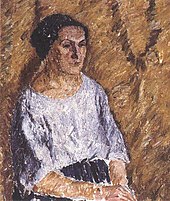Nadeschda Andrejewna Udalzowa
Nadeschda Andreevna Udalzowa ( Russian: Надежда Андреевна Удальцова , scientific transliteration Nadežda Andreevna Udal'cova ; * December 29, 1885 July / January 10, 1886 greg. In Orjol ; † January 25, 1961 in Moscow ) was a Russian painter , who died on January 25, 1961 in Moscow Russian avant-garde counts.
life and work
Between 1905 and 1908, Nadezhda Udalzowa, together with her sister Lyudmila Prudowskaja and Olga Rosanowa, attended a school in Moscow led by the artists Konstantin Juon and Iwan Dudin and the Institute for Painting, Sculpture and Architecture in Moscow.
She spent 1912 to 1913 with Lyubow Popowa in Paris, where she studied art in La Palette with Jean Metzinger and Henri Le Fauconnier . In 1913, after her return to Moscow, she worked in the studio The Tower of Vladimir Tatlin continued with Alexander Vesnin and Liubov Popova, where she created pictures in which the Cubist proportion to the futurism prevailed.
In 1914 she took part in the Jack of Diamonds exhibition in Moscow. In 1915 she became a member of the Supremus artist group and took part in the Tramway V exhibition. In the same year she was one of the participants in the so-called Last Futurist Exhibition 0.10 in St. Petersburg, then Petrograd , which marked the breakthrough to non-representational art in Russia. This was the artist's most fruitful creative phase, dealing with the theories of Malevich and Tatlin. A whole series of studies were carried out on the relationship between colors and shapes in space and the tension they create.
As assistant to Kasimir Malewitsch , she taught at the SWOMAS Art Academy in Moscow in 1918 and was later appointed professor of painting there. During this time she was significantly influenced by Suprematism . The First Russian Art Exhibition in Berlin in 1922 exhibited her paintings Still Life and Am Piano . In the years 1921-1934 she continued teaching at Wchutemas and Wchutein , and from 1930 to 1934 also taught at the Moscow Textile Institute and Polytechnic Institute.
In the 1920s she turned away from the avant-garde art movement and returned to figurative- naturalistic painting . Nadezhda Udalzowa was married to the artist Alexander Drewin (1889-1938), with whom she undertook various trips to the Urals , the Altai and Armenia in the period from 1926 to 1934 . Solo exhibitions of her and Drewin's works were held in 1928 at the State Russian Museum in Leningrad and in 1934 at the Museum of Culture and History in Yerevan (Armenia). After Drewin's assassination in the Stalinist terror in 1938, Udaltsova mainly painted landscapes in a naturalistic style. In 1945 she showed her work in a solo exhibition in Moscow.
Works (selection)
- 1914–1915 Am Piano , oil on canvas, 107 × 89 cm
- 1914–1915 Cubic composition , oil on canvas, 63.5 × 49.5 cm, private collection Moscow - 1985 Collection Ludwig, Cologne (ML 1383, neg. 195292)
- 1916 Composition , gouache over pencil on gray paper, 46.2 × 37.5 cm, Galerie Gmurzynska, Cologne - 1982 Ludwig Collection, Cologne (Dep. Coll. L. 1982/536, Neg. 190408)
Exhibitions
- 1979–1980 women artists of the Russian avant-garde 1910–1930 , Galerie Gmurzynska, Cologne
- 1986 Russian avant-garde 1910–1930 Collection Ludwig Cologne , Kunsthalle Cologne
Collections
- Tretyakov Gallery , Moscow
- Collection of the Museum Ludwig , Cologne
- Costakis Collection, State Museum of Contemporary Art (Thessaloniki)
literature
- Book for the exhibition 16. Russian Avantgarde 1910–1930 Collection Ludwig, Cologne , in the Kunsthalle Cologne, April 16 - May 11, 1986 (edited and with an introduction by Evelyn Weiss)
Web links
- Information about the artist and her works (Russian)
- Works in the Costakis Collection (Greek, English, Russian)
Individual evidence
- ↑ Bowlt, John E. and Drutt, Matthew (eds.): Amazons of the avant-garde. Alexandra Exter, Natalja Goncharova, Lyubov Popova, Olga Rosanowa, Varwara Stepanowa and Nadeschda Udalzowa. New York 1999. p. 45
| personal data | |
|---|---|
| SURNAME | Udalzowa, Nadezhda Andreevna |
| ALTERNATIVE NAMES | Надежда Андреевна Удальцова |
| BRIEF DESCRIPTION | Russian painter |
| DATE OF BIRTH | January 10, 1886 |
| PLACE OF BIRTH | Oryol |
| DATE OF DEATH | January 25, 1961 |
| Place of death | Moscow |
